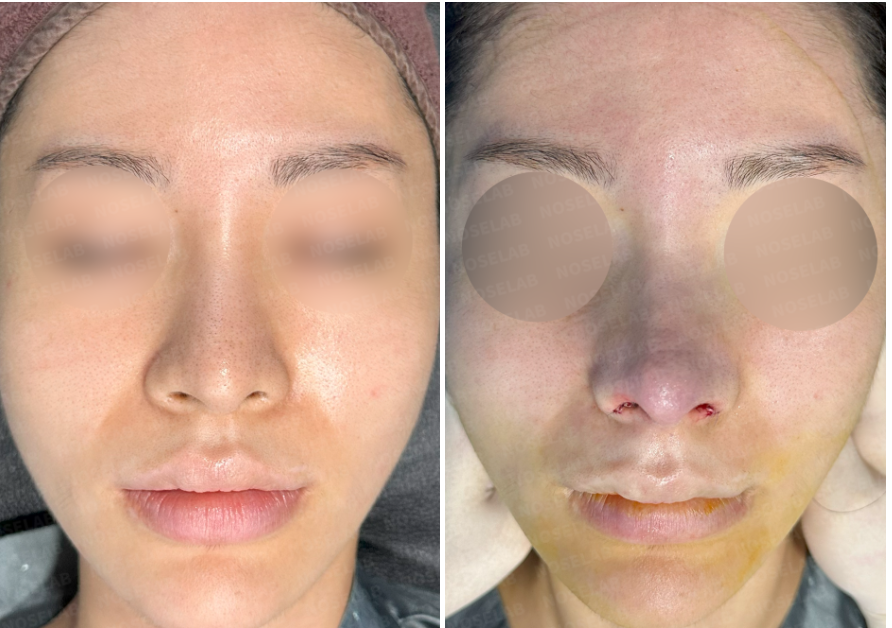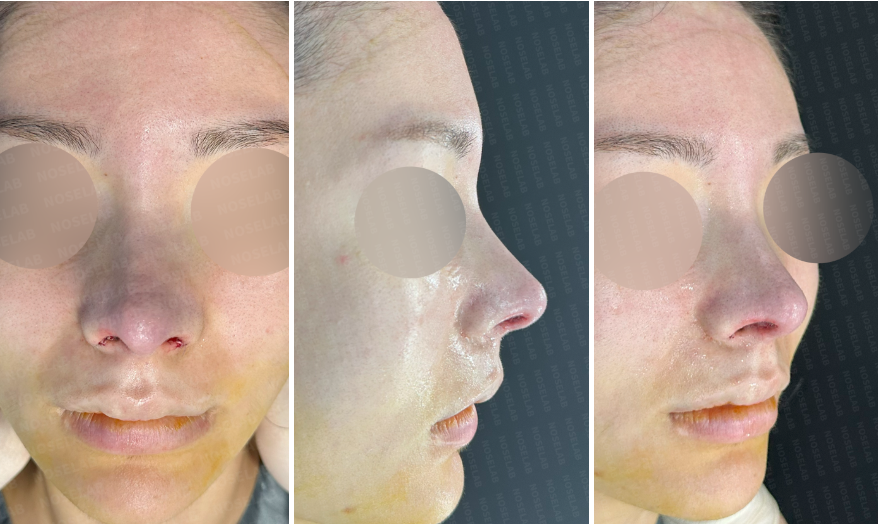Hello, this is Dr. Cha-Young Kang, Director of Nose Lab Clinic.
Today, I’d like to share a rhinoplasty case involving a patient who presented with multiple concerns: a long nose, a drooping nasal tip, a wide nasal bridge, and a bulbous tip.
This patient had previously undergone rhinoplasty using silicone, ear cartilage, and Medpor, but was seeking a more refined yet natural appearance.
1. Pre-Surgery Design Consultation
Let’s take a closer look at the patient's pre-operative condition:
Pre-Surgery Design Photos: Front, Left Oblique, and Side Views
Front View:
The nasal starting point is high.
The nose has a bulbous and wide appearance, giving a strong impression of a rounded, broad nose.
Long nose overall.
Side View:
The nasal tip is drooping.
The starting point at the nasal root (glabella) is high.
The nasolabial angle (the angle between the nose and the upper lip) is less than 90 degrees, making the tip appear even more droopy.
Noticeable protrusion of the upper lip (suggesting a convex profile).
Oblique View:
The nose appears long.
The nasal tip seems too pointy in this view.
Pre-Surgery Design Consultation: Right Side, Oblique, and Nasal Base Photos
Nasal Base:
Asymmetry in the nostrils is evident.
The columella appears tilted to the left.
Patient's Requests:
a) Reduce the size of the nasal alar (nostril width).
b) Elevate the drooping nasal tip.
c) Achieve a refined yet natural appearance without looking artificial.
2. Surgical Plan
Considering the patient's condition and specific requests, we formulated the following surgical plan:
a) Septal Extension Graft using Autologous Rib Cartilage
b) Removal of Medpor
c) Tip Reshaping
d) Reduction of Nasal Base Width
e) Repositioning and Tying of the Alar Cartilage
f) Nasolabial Angle Adjustment
3. Surgical Procedure Details
All procedures were performed using a closed approach (endonasal technique) as follows:
a) Medpor Removal:
Medpor, previously inserted on both sides of the septum to extend the tip, was carefully identified.
The Medpor implant was removed without causing any damage to the existing septal cartilage.
Medpor Removal from the Nasal Tip
b) Septal Extension Graft Using Autologous Rib Cartilage:
The patient's rib cartilage was harvested and used to extend the nasal septum.
This technique corrected the elongated, drooping appearance, and addressed the deviation of the nasal tip and columella tilt, while also improving the nostril asymmetry.
c) Nasal Tip Reshaping:
To achieve the rounded tip shape the patient desired, we reused the previously placed ear cartilage and soft tissue.
The redundant portions from the prior alar lowering surgery, which had used ear cartilage, were removed and repurposed for the nasal tip reconstruction.
d) Nasal Base Reduction:
To correct the wide nose, we performed a nasal base reduction surgery, effectively narrowing the nostrils and enhancing the nasal shape.
e) Repositioning and Tying of the Alar Cartilage:
The bulbous nasal tip was refined by repositioning the alar cartilages and employing a suturing technique to achieve a more defined and natural tip appearance.
f) Nasolabial Angle Adjustment:
To improve the drooping tip and address the appearance of a protruding mouth, we adjusted the nasolabial angle to create a more balanced profile.
4.Before and After Photo Comparison
Upon reviewing the immediate post-surgery photos, the following improvements are evident:
Frontal view before surgery (left) after surgery (right)
The previously wide and broad nose has been slimmed down, giving a more refined appearance.
The bulbous nasal tip has been naturally corrected, resulting in a more defined and aesthetically pleasing shape.
The starting point of the nose at the nasal root (between the eyebrows) has been lowered, creating a softer and more balanced transition from the forehead to the nose.
45-degree angle view before surgery (left) after surgery (right)
The previously drooping nasal tip has been naturally lifted, giving the nose a more refined and balanced appearance.
The sharp-looking nasal tip has been reshaped into a rounder and softer form, aligning with the patient's desired aesthetic.
Side profile view before surgery (left) after surgery (right)
The previously elongated nose has been naturally shortened, contributing to a more balanced facial profile.
The nasolabial angle has been corrected to approximately 95 degrees, improving the drooping appearance of the nasal tip.
There is a noticeable improvement in the appearance of the protruding upper lip, enhancing the overall facial harmony.
Nostrils before surgery (left) after surgery (right)
The asymmetry of the nostrils has been corrected, resulting in a more balanced nasal base.
The columella, which was previously tilted to the left, has been straightened, contributing to a more symmetrical and aligned appearance.
5.Post-Surgery Photo Collection
Photos taken immediately after surgery, frontal view, 45-angle view, and side profile.
Photo of the nostrils
6.Overview
This case is an excellent example of successfully addressing multiple nasal concerns simultaneously. Notably, the safe removal of Medpor from a previous surgery and the use of autologous rib cartilage to create a more natural nasal structure were key highlights.
The patient presented with various issues, including a long nose, drooping tip, wide nasal base, and bulbous tip. All of these were corrected in a single surgery, achieving the patient’s desired result of a refined, yet natural look. This outcome was made possible through meticulous surgical planning and precise execution.
A particularly impressive aspect of this surgery was the reuse of ear cartilage and soft tissue from the previous procedure to reconstruct the nasal tip. This minimized the need for additional tissue harvesting and demonstrated an efficient use of existing resources.
The correction of the nasolabial angle not only improved the drooping nasal tip but also contributed to a noticeable improvement in the patient’s protruding mouth. This significantly enhanced the overall facial balance, which was one of the key successes of this surgery.
In conclusion, this case showcases the powerful impact of a customized approach to rhinoplasty, addressing both aesthetic and functional concerns while ensuring the patient’s satisfaction with a natural and elegant outcome.
Conclusion
I hope this case offers reassurance to those struggling with complex nasal concerns, such as a long, drooping, wide, or bulbous nose. Even with multiple issues, a well-planned surgery and precise techniques can create a naturally beautiful result.
A key takeaway from this case is the potential risks associated with using foreign materials like Medpor or mesh in the nasal tip. These materials are not ideal due to the risk of inflammation and the higher likelihood of contracture formation. It is often best to completely remove such materials to prevent complications.
However, removing foreign materials requires great care and precision. Materials like Medpor or mesh often adhere to surrounding tissues, making complete removal a delicate and challenging process that requires highly skilled and experienced surgeons. If you are considering foreign material removal or revision surgery, I strongly recommend consulting with a specialist who has extensive experience in these procedures.
Through a comprehensive approach that simultaneously considers functional and cosmetic improvements, we aim to create beautiful noses that breathe easy.
With Noselab Clinic you can achieve a beautiful and healthy nose!
Thank you.











Comments